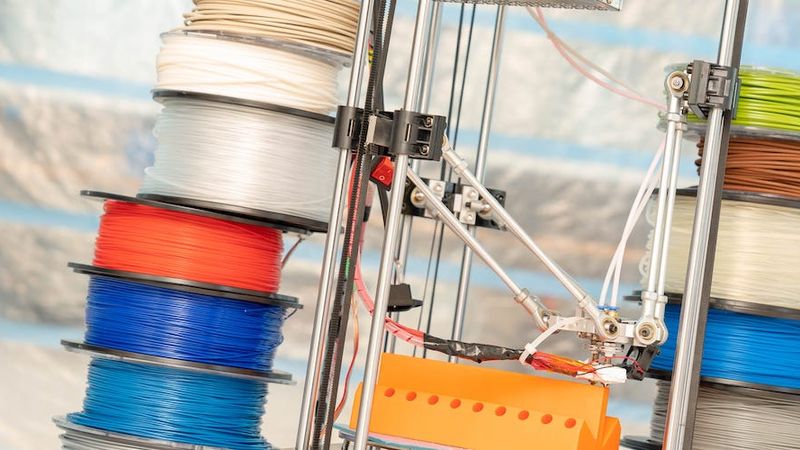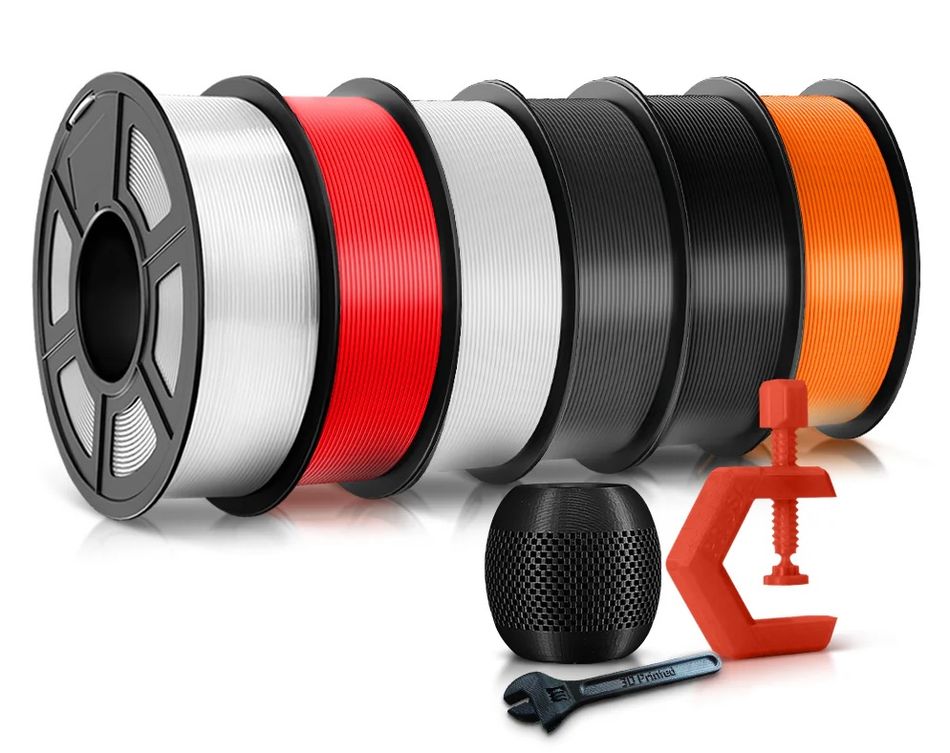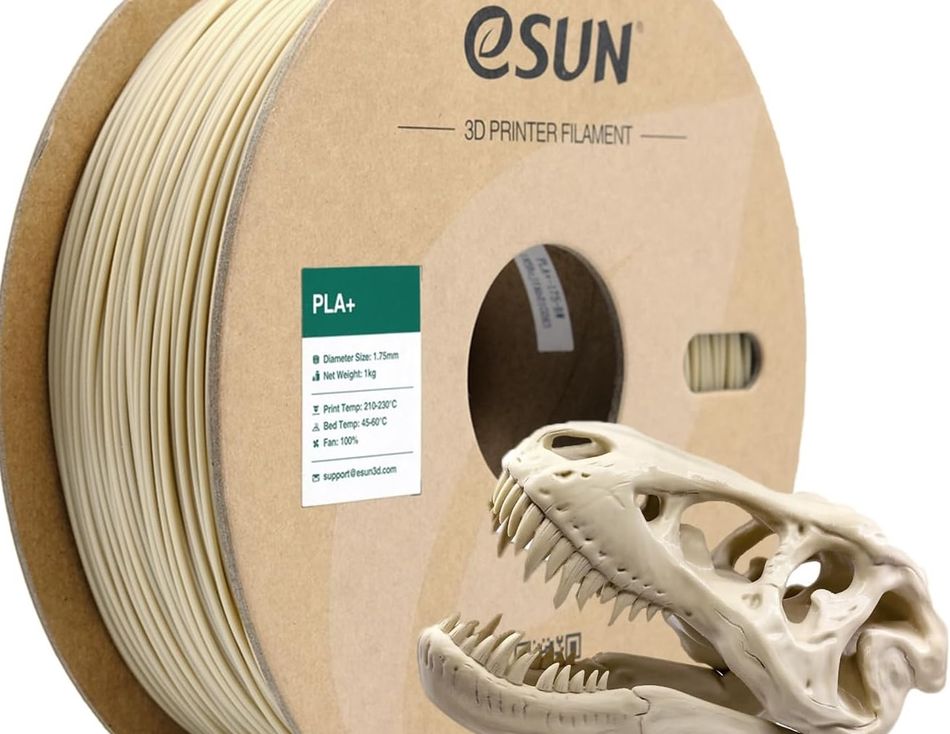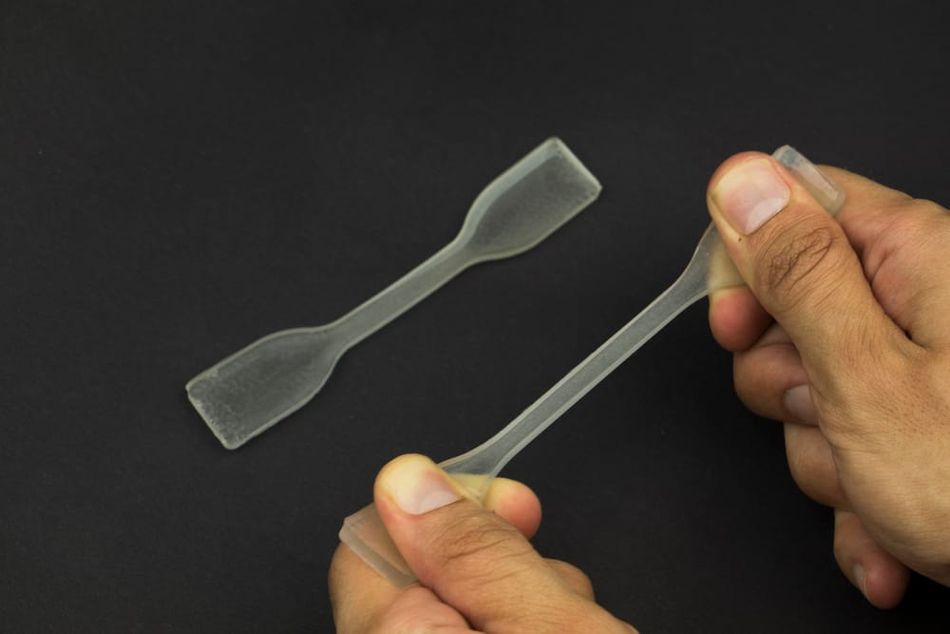PETG vs PLA Plus: Comparison of Two Affordable Filaments
Most beginners start their 3D printing journey with PLA filament. After that, two popular material options are PETG, which performs better at higher temperatures, and a modified version of PLA known as PLA+.

PLA+ and PETG are both common FDM filaments
PLA (polylactic acid) is a perfectly good material for most prints on an FDM 3D printer. Easy to print, easy to buy, and easy to find the right settings for, standard PLA is truly an additive workhorse. It will likely reign among consumer 3D printing materials for many years to come.
However, PLA has its limitations. In addition to being brittle and lacking toughness, this common thermoplastic also suffers at high temperatures. That raises the important question: what is the best material to choose next after PLA? While ABS is often posited as the main alternative, a quick glance at the filament category on Amazon shows that buyers are regularly turning to two other materials: PETG, a modified form of the plastic used to make water bottles, and PLA Plus (PLA+), a modified version of standard PLA with performance-boosting additives.
For many users, this means that PETG vs PLA Plus becomes a real dilemma. Do you go for a totally different material, or do you stick with the basic material properties of PLA improved with a few minor tweaks (PLA+)? This article goes over the main elements of the PETG vs PLA Plus dilemma, examining the pros and cons of each 3D printing filament.
What Is PETG Filament?
PETG (Polyethylene Terephthalate Glycol) is a durable and chemical-resistant 3D printing filament that offers a balance between strength, flexibility, and ease of use. It is a modified version of PET, the plastic used in water bottles, with added glycol to improve durability and printability. PETG is stronger and more impact-resistant than PLA while being easier to print than ABS, making it a good choice for some functional parts.
PETG prints at a nozzle temperature of about 230–250°C and a bed temperature of 70–90°C. It has low shrinkage and minimal warping, which allows for consistent, large prints without significant deformation. However, it is more hygroscopic than PLA, meaning it readily absorbs moisture from the air, which can cause print defects if not properly stored.
One of PETG’s advantages is its chemical and UV resistance, making it suitable for outdoor applications, medical devices, and food-safe containers. Some PETG filaments are FDA-approved for food contact, though post-processing and cleanliness are essential. It adheres well between layers, ensuring strong, durable prints, but can be prone to stringing if retraction settings aren’t optimized.
What Is PLA+ Filament?
PLA+ is, according to its manufacturers, an enhanced version of standard PLA (Polylactic Acid) with added modifiers, plasticizers, or impact-resistant agents to improve its mechanical properties. While PLA is known for ease of printing and biodegradability, PLA+ can offer greater toughness, flexibility, and sometimes higher temperature resistance compared to regular PLA.
Note that PLA+ is not a scientific term, but a marketing one. It also goes by other names like "Enhanced PLA." As such, different brands of PLA+ can have quite different compositions and offer different levels of performance.
One key advantage of most types of PLA+ is an increased impact resistance, making the material less brittle than standard PLA. This makes PLA+ suitable for some functional parts, tools, and prototypes that require more durability. Additionally, some formulations of PLA+ have higher heat resistance, allowing prints to withstand temperatures above 60°C, whereas regular PLA softens around 55°C.
Printing with PLA+ is similar to standard PLA but may require a higher nozzle temperature (200–230°C) to accommodate the modified formulation. It typically maintains the low warping and easy printability of PLA while offering improved layer adhesion and surface finish.
Available PLA+ Filaments
Many filament manufacturers offer a version of PLA+. Some affordable consumer-level products include:
SUNLU PLA+ 2.0: An upgraded filament known for its enhanced impact resistance and durability, supporting high-speed printing up to 300 mm/s.
ELEGOO PLA+: Made from eco-friendly raw materials, this filament features low warpage, excellent printability, and high strength, making it suitable for functional parts and prototypes.
eSUN PLA+: Offers improved toughness and reduced brittleness compared to regular PLA, with good layer adhesion and a smooth surface finish.
Hatchbox PLA PRO+: A modified PLA filament that provides enhanced mechanical properties, including increased strength and durability, while maintaining ease of printing.
Overture Super PLA+ Professional: Engineered for higher toughness and less brittleness, this filament is designed for a wide range of applications requiring improved mechanical performance.
What About Hyper PLA?
Hyper PLA (or high-speed PLA) is another modified PLA formulation designed for fast 3D printing instead of tweaked material properties. Like PLA+, it is an unregulated term, so do not expect to see much consistency between different products.
High-speed PLA filaments typically includes flow enhancers, impact modifiers, and heat-resistant additives to reduce viscosity, improve layer bonding, and prevent warping at high speeds, sometimes above 500 mm/s. These enhancements supposedly allow for smoother extrusion, reduced oozing, and increased mechanical properties compared to standard PLA. They may also help to maintain color consistency at high speeds.
Several brands offer high-speed PLA filaments:
- Creality Hyper PLA
- Polymaker PolySonic PLA
- eSUN ePLA-SE
- Sunlu High Speed PLA
These filaments cater to users aiming for fast yet reliable prints, especially in high-speed 3D printing setups.
PETG vs PLA+ Material Properties Comparison
When making an assessment of the PETG vs PLA Plus question, the most important thing to consider is material properties. And unlike, for example, the debate over PLA vs PLA Plus — where the differences are quite minor — PETG (polyethylene terephthalate with a glycol modification) and PLA Plus offer significantly different properties.
There is, however, a slight stumbling block when it comes to comparing PETG filament to PLA+ filament. And that is that PLA+ is a non-scientific term created by filament manufacturers. That basically means that there is no “standard” table of properties for PLA+ like there is for materials such as PLA, PETG, and ABS. If you want to know the exact impact resistance or heat deflection point for a PLA+ filament, you need to find the data sheet for that particular manufacturer’s filament. In other words, that enticing “Plus” could indicate a boost to impact resistance, temperature resistance, or something else entirely.
With that in mind, the figures we will use in this section will be taken from one specific material manufacturer. We have chosen Chinese company eSUN, because eSUN’s PLA+ is the most widely sold PLA+ filament on the market. Furthermore, that same company’s PETG filament is broadly representative of PETG filaments in general.
Tensile Strength
Tensile strength is one of the most important physical property for 3D printing materials if the printed parts are going to be given some kind of functional application.
There are different types of strength, but tensile strength can be defined as the ability of a polymer to resist breakage when under tension, i.e. when it is being pulled or stretched. Despite its low price, standard PLA has very good tensile strength, and PLA+ retains that strength while modifying other aspects of the material. PETG offers a fairly high level of tensile strength — higher than ABS, for instance — but not as high as PLA or PLA+.
PLA Plus: 65 MPa
PETG: 49 MPa
Recommended reading: Strongest 3D printer filaments
Impact Resistance
Another important physical property of 3D printing materials is impact resistance (or impact strength). Impact resistance is a material’s resistance to breakage; technically, it can be defined as the amount of energy that the material is able to absorb without breaking. Impact resistance is the same thing as toughness, and the toughest materials tend to also offer a degree of flexibility.
Standard PLA offers notoriously poor impact resistance. It is very brittle and can shatter into small pieces upon impact. However, one of the main advantages of PLA+ is its improved toughness over standard PLA. PETG, on the other hand, offers a good balance between tensile strength and impact strength. It has much better impact resistance than standard PLA and similar impact resistance to PLA+. In the case of eSUN filaments, PLA+ actually outperforms PETG for impact resistance, though this is not the case for all brands.
PLA Plus: 8.5 kJ/m2
PETG: 7.6 kJ/m2
Temperature Resistance
Some 3D printing materials offer better heat resistance than others, i.e. they can maintain their shape and performance at higher temperatures. A good way to compare the temperature resistance of materials is to examine their heat deflection temperature: a measure of a material’s resistance to deformation when under load at an elevated temperature.
As we know, ordinary PLA is one of the worst-performing filaments in terms of heat resistance. PLA+ offers slightly improved heat resistance, but the thermal properties of the base material cannot be radically changed via additives. PETG, meanwhile, is not really known for its thermal performance either, but it is certainly better than PLA+ when it comes to temperature resistance, as shown by the heat deflection values below.
PLA Plus: 52 °C
PETG: 64 °C
Ease of Printing
One of the main reasons for the enduring popularity of standard PLA is its printability. Although it does not offer remarkable material properties, it is fairly resistant to common printing issues like warping and stringing, making it easy for beginners to fire off prints without much tweaking of print settings. Importantly, it also has a low printing temperature, working well at low extrusion temperatures and bed temperatures, and it does not require extensive build surface preparation.
But what about PLA Plus? Although fairly similar to standard PLA, this modified version of the popular thermoplastic contains certain additives that affect its printability. Notably, PLA+ usually requires a slightly higher nozzle temperature and heated bed temperature than regular PLA. PETG, meanwhile, requires even higher temperatures — a demand that is justified, however, by the material’s superior temperature resistance and good inter-layer adhesion.[1]
The most common printing issue with PETG is oozing and stringing (molten material dripping from the nozzle), which can often be mitigated by adjustment of retraction settings.
Recommended reading: PETG stringing: What it is & how to prevent it during 3D printing
Bed Adhesion
Both PLA+ and PETG are fairly easy to print in terms of build surface preparation. Under-adhesion is a potential issue with PLA+, especially at lower temperatures, but the material usually prints well on standard smooth surfaces like glass or smooth PEI.
PETG adheres easily to any build surface; in fact, to prevent over-adhesion (parts sticking too well to the bed) and facilitate easy part removal, it is recommended to use a textured PEI sheet as a build surface, or a disposable surface like blue painter’s tape.[2]
PETG vs PLA+ Post-Processing Considerations
PLA+ and PETG are both capable of producing high-quality parts with a good surface finish, though post-processing is required to get the best possible finish. The two materials are suited to similar post-processing methods. Note, however, that neither material is suitable for acetone smoothing, which only works for smoothing ABS parts.
As with standard PLA, post-processing PLA+ is fairly user-friendly, and the same applies to PETG. One common post-processing method is sanding, which involves rubbing the surface of the part manually using sandpaper, starting with a coarse grit and moving gradually towards a fine grit, then finally finishing with a wet polish. Sanding is an effective way to reduce the appearance of layer lines, and it is often combined with the use of a primer or filler for plugging large holes or visible gaps between layers.
Another finishing option for both PLA+ and PETG is coating the parts with an epoxy resin such as XTC-3D. This process seals up porous parts of the prints, increases strength, and creates a protective layer around the printed material. According to Dizon et al, it is “advisable to use a two-component solution (such as epoxy) or one-component spray to smoothen the surface of rigid plastics such as PC, PET, or PLA.”[3]
PETG vs PLA+ Uses
The material properties of PETG make it ideal for prototypes or low-level functional parts that will experience some degree of stress or wear, such as mechanical components, protective covers, and housings. PETG is also widely used for creating food containers and other items that require a high level of chemical resistance. Its low shrinkage rate also makes it a good choice for large prints or precision parts.
PLA+ is often used for decorative prints, models, and prototypes, as well as parts that don’t require extreme strength or temperature resistance (but that require a slight improvement over PLA). Its aesthetic appeal is often a deciding factor for designers, as it can produce smooth finishes and vibrant colors. It’s also popular for educational and hobbyist projects due to its user-friendly nature.
PETG vs PLA+ Cost
PLA+ and PETG are both beginner-friendly 3D printing materials. Neither of these popular filaments will deliver the highest possible print quality, but both are highly affordable. In fact, PLA+ has always been marketed squarely at the consumer market, where premium or high-performance materials are either too expensive or too demanding for use on cheap hardware.
Sticking with eSUN filaments for a moment, it is worth pointing out that there is a negligible price difference between this company’s PLA+ and PETG filaments: both sell for about $23 per 1 kg spool.
There is, however, a significant variation in pricing between different manufacturers. The table below shows a mixture of budget and mid-price filaments.
Ultimately, when weighing up the question of PETG vs PLA Plus, it is better to consider the respective material properties of each material rather than looking to save a matter of a few dollars per spool of filament.
PLA+ (or equivalent) | PETG | |
SUNLU | $20–26 via Amazon | $16–21 via Amazon |
eSUN | $23–26 via Amazon | $22–24 via Amazon |
Polymaker | $30 via Amazon | $22 via Amazon |
MatterHackers (PRO Series) | $45–57 via MH | $57 via MH |
Conclusion
PLA+ vs PETG is a close-fought battle between two everyday 3D printing filaments with low price tags. In general, it can be beneficial to use PLA+ over PETG when prioritizing tensile strength, using a low-temperature extruder (or print bed), or adding minor mechanical improvements to parts that have been designed for standard PLA. Conversely, using PETG may be preferable when prioritizing temperature resistance or when other materials have provided adhesion issues.
Frequently Asked Questions
Which filament is easier to print?
PLA+ is easier to print than PETG because it has less stringing, lower print temperature requirements , and better bed adhesion. PETG requires higher temperatures, fine-tuned retraction settings, and can sometimes struggle with bed adhesion.
Is PLA+ or PETG more heat-resistant?
PETG has a higher heat resistance, typically around 75–80°C, whereas PLA+ varies by brand but usually softens above 60°C. If you need better thermal performance, PETG is the safer choice.
When should I choose PETG over PLA+?
Choose PETG if you need weather resistance, chemical resistance, and higher durability. Choose PLA+ if you want easier printing with improved strength over standard PLA but don’t need PETG’s extra toughness or heat resistance.
References
[1] Keim A, Hanson C, McCoy C, McClain M. Characterization of Interlayer Healing in PETG Parts Made With Fused Filament Fabrication. InAIAA SCITECH 2025 Forum 2025 (p. 1555).
[2] How to Get Perfect PETG Prints on Ender-3: Correct Settings [Internet]. Creality. 2020 [cited 2022Jun6].
[3] Dizon JR, Gache CC, Cascolan HM, Cancino LT, Advincula RC. Post-processing of 3D-printed polymers. Technologies. 2021 Sep;9(3):61.




